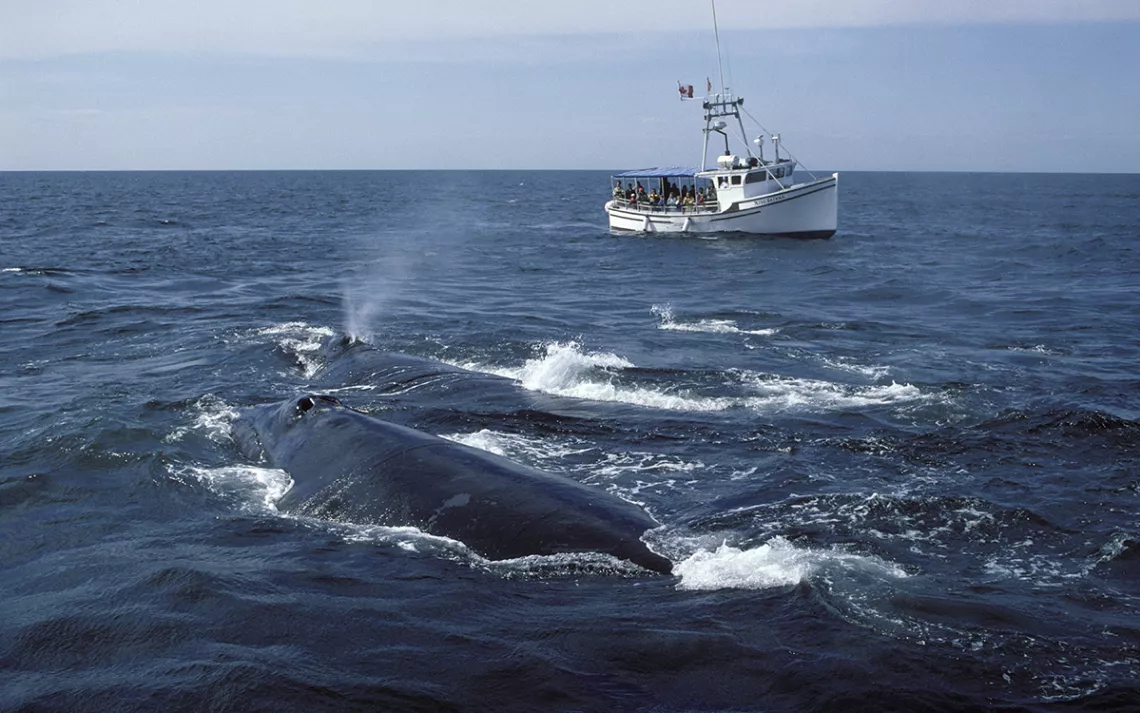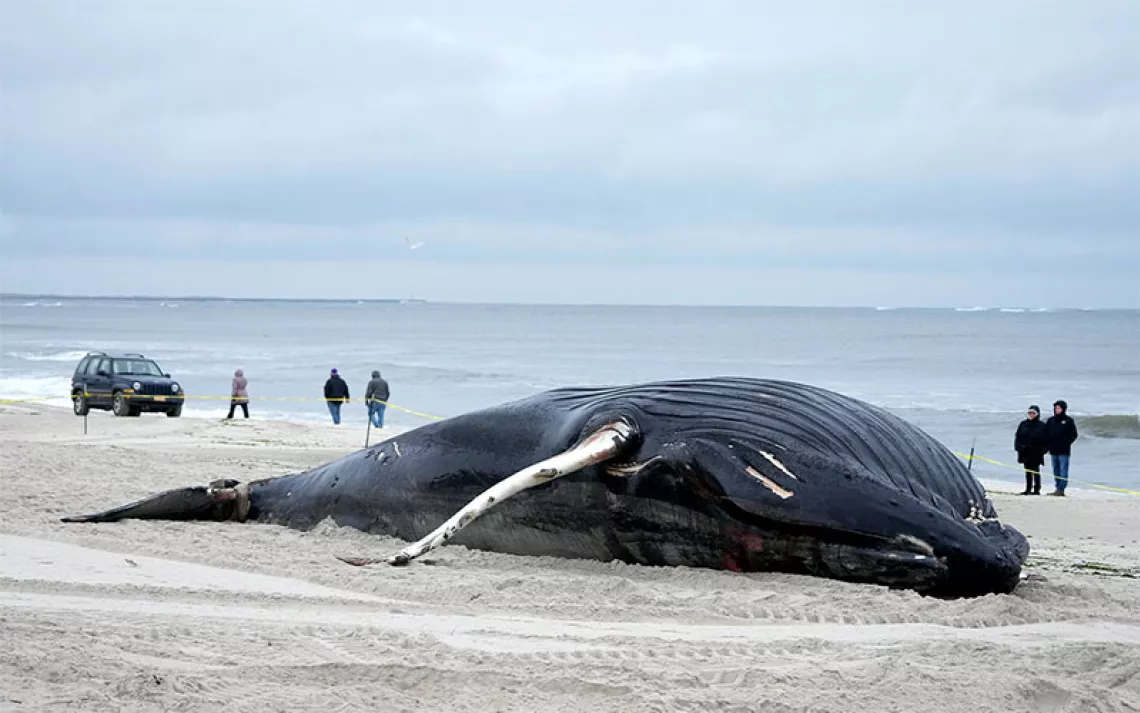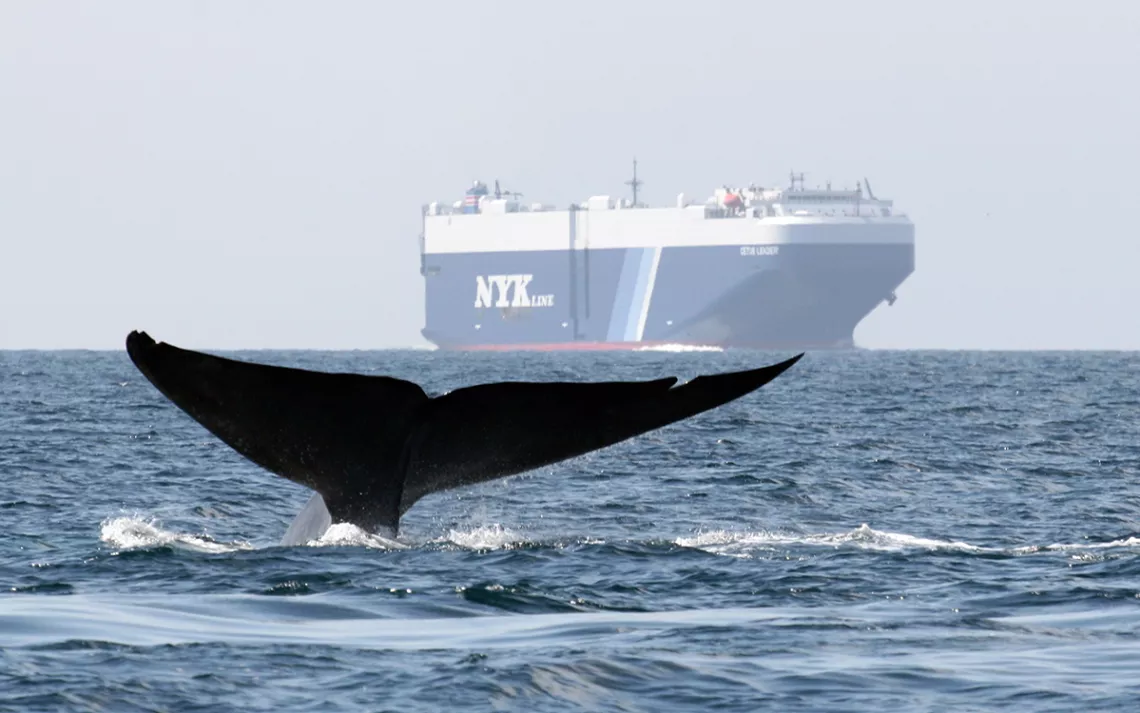Extinction Is Looming. Everyone's Fighting.
New rules are coming for the lobster Industry. Will they save the right whale?

Northern right whales in the Bay of Fundy. | Photo by Francois Gohier
With the possible exception of the Megalodon shark (now extinct for at least 3.6 million years) humankind has been the most effective killer of whales in history. A study in 2015 put the final death toll of 20th-century commercial whaling at about 2.9 million, before the International Whaling Commission’s ban in 1986 brought it (mostly) to an end.
Remarkably, not a single species had gone extinct in the frenzy for oil, baleen, and ambergris, and gradually, populations of whales began to fill the oceans again. Some, like humpback whales in the western South Atlantic, have made a strong recovery. But others haven’t been so lucky.
A slow-moving grazer with a head like a snowplow, the North Atlantic right whale is a regular visitor to the New England coast and one of the first species to be hunted by American whalers. The right whale count recovered from 270 whales in 1990 to almost 500 two decades later. But around 2010, numbers began to fall again. The population has declined ever since and currently stands at less than 350. In 2020, the International Union for Conservation of Nature changed the North Atlantic right whale’s status back to “critically endangered.” At least 34 have died since 2017, including four in 2021 alone.
Scientists studying the decline have concluded that humans are to blame. In 2018, an international group of scientists compared the number of North Atlantic right whale calves born each year to the calf counts from three populations of the Southern right whale, its nearest relative south of the equator. The Southern rights showed a clear trend upward from 1992 to 2016, but the North Atlantic species couldn’t keep pace. The best explanation, wrote the authors, was too many dead females.
“Down there, the whales get old before they die,” says Colleen Coogan, marine mammal and sea turtle branch chief at the National Marine Fisheries Service. “Up here, right whales don’t live long enough to die of old age.” When a cause can be determined, right whale deaths are attributed to one of two culprits: blunt-force injuries and propeller wounds from colliding with ships and a slow death by starvation and infection after becoming tangled in nets and fishing rope. Eighty-six percent of right whales have been entangled at least once, according to the New England Aquarium.
New rules are here to save the day. Or are they?
This May, new rules created for the lobster industry by the National Marine Fisheries Service (the branch of NOAA responsible for fisheries management) will become official policy for boats operating in right whale territory. NOAA's new rules are part one of a two-phase plan that will take place over 10 years. In phase two, the rules will become more strict for the Mid-Atlantic lobster fishery as well as some other East Coast fisheries.
NOAA estimates that lobster and Jonah crab traps are responsible for 95 percent of vertical end-line ropes in the areas where whale protections apply and therefore pose the most risk for entangling whales. The Fisheries Service says these changes will reduce the risk of death and serious injury by 69 percent. But in the months after the rules were finalized, the agency has seen pushback from conservation groups, who argue the new protections aren’t enough, and lobster fishing crews, who say the rules will harm their business.
The rules require lobster crews to attach more lobster traps to each line (which would reduce the number of end-line ropes hanging vertically in the water) and to splice sections of “weak rope” into their fishing lines, which are designed to break under 1,700 pounds of pressure at most. The latter measure is based on research from the New England Aquarium, which examined ropes taken from 70 entangled whales and determined that weaker rope could reduce life-threatening entanglements by 72 percent while still being reliable for fishermen.
But the fact that weak rope has not been field-tested worries researchers who would prefer to limit or remove rope from the equation entirely until the species rebounds. “Without that evidence, you're kind of undertaking a scientific experiment on this species that’s critically endangered,” says Francine Kershaw, a staff scientist with the Natural Resources Defense Council. Even if a rope doesn’t kill the whale, says Kershaw, it can still cause harm, especially to calves.
The National Marine Fisheries Service has also designated two new areas along the New England coast that will be seasonally closed to lobster fishing. But conservation groups have argued these closures don’t provide enough protection. For example, a restricted area south of Nantucket island would be closed to fishing from February to April. But one analysis of whale sightings released last summer by the National Marine Fisheries Service and the New England Aquarium identified the area as a hot spot for whales in the summer and winter too.
Currently, it’s very difficult to prove where whales are getting entangled, and this has been a major sticking point during rulemaking. “That’s the big problem no one’s figured out how to solve,” says Colleen Coogan. Right whales are highly mobile and difficult to track. Tagging them with GPS devices risks injuring them, and so scientists and government agencies rely on sightings from ships and planes as well as underwater microphones to listen for whale songs. To determine where and when lobster fishing should be off-limits, the National Marine Fisheries Service used a computer model that cross-references those whale sightings with the location of fishing gear and calculates the risk of entanglement.
The climate crisis has made things more complicated, as some whales have been changing their travel habits in response to warming waters. In 2017, at least nine whales died in the Gulf of St. Lawrence in eastern Canada when an influx of migrating whales collided with a busy snow crab fishing season. The area saw few right whales before 2015, but evidence suggests the Gulf is becoming a regular stop on their annual migration. A recent study found that about 40 percent of North Atlantic right whales visited the Gulf of St. Lawrence from 2015 to 2019, with most returning on a yearly basis.
“We’re actually not very good at predicting where they’re going to go,” says Peter Corkeron, a senior scientist at the New England Aquarium who coauthored the 2018 study comparing the survival rates of North Atlantic right whales and Southern right whales. He believes the new rules will not be enough to reverse the right whale's decline and cites the Endangered Species Act, which states that a federal agency cannot allow an activity that “jeopardize[s] the continued existence of endangered or threatened species.”
The National Marine Fisheries Service first concluded that lobster fishing placed the North Atlantic right whale in jeopardy in 2001. After it put new protections in place, the agency concluded in several more analyses that the fishery no longer posed a threat, even as whale numbers leveled off and began to decline. It took a 2018 lawsuit by the Center for Biological Diversity and other conservation groups to force the agency to come up with the new rules, on the grounds that it was violating the Endangered Species Act and Marine Mammal Protection Act.
The National Marine Fisheries Service now estimates the whale can lose less than one member per year before it’s on a path to extinction, and last February, an 11-year-old male named Cottontail died of rope injuries. The agency says their new plan would allow the lobster fishery to operate without placing the whales in jeopardy. But “it’s becoming less and less tenable as these whales blink out that they can keep doing that,” says Corkeron.
The view from the lobster boats
Lobster fishers have voiced their own objections, saying the new rules unfairly target their industry. “This plan is a lose-lose because it will all but eliminate the Maine lobster fishery yet still fail to save endangered right whales,” Patrice McCarron, the executive director for the Maine Lobstermen’s Association, wrote in an email to Sierra. She takes issue with NOAA’s “one size fits all” approach and believes whale protections should be flexible and tailored to local conditions. The state submitted its own proposal for reducing entanglements, but NOAA rejected it, saying it did not reduce the risk far enough.
Maine lobster boats landed about 96 million pounds of lobster in 2020, amounting to about $400 million in revenue. Over the past two decades, the industry has complied with previous whale protections by making expensive changes to its equipment, says McCarron, including marking gear, replacing floating rope with sinking rope, and adding breakable plastic links and weak rope similar to that required by the new rules. And more changes could be on the way.
One source of hope for the right whale is ropeless lobster trap technology, which floats to the surface at the press of a button instead of having to be hauled up. But it needs some work. “We've moved beyond it being experimental, but it’s still not totally off the shelf,” says Katharine Deuel, a senior officer for marine conservation at the Pew Charitable Trusts, which has supported research on ropeless gear. “These units are being made to order.”
Ropeless lobster traps are also expensive. The price of different models varies but are generally more than a thousand dollars per unit (a regular trap costs about $100). At the moment, says McCarron, it’s unclear whether the price will go down enough—and whether the gear will work well enough—to keep lobster fishing profitable.
Pew and other groups are advocating for funding from the federal government to help fisheries in North America convert to ropeless traps. “It definitely can't all be put financially onto the fishing industry,” says Deuel. Ropeless gear might also help protect other species like humpback whales, which are similarly injured by crab-fishing equipment in California. “This transition is something that everyone wants to have happen,” says Deuel. “And everyone, in some way, is responsible for making it happen.”
In the meantime, Pew is calling on the government to do more. Along with groups like Environment America and the Georgia Wildlife Federation, Pew petitioned Gina Raimondo, the US Secretary of Commerce, to take emergency action last summer to protect the whales on a timeline faster than NOAA’s 10-year plan. Their requests include more seasonal restricted areas in the Gulf of Maine that they say would provide better protection for right whales while keeping lobster boats in business.
“This is the fork in the road,” says Regina Asmutis-Silvia, executive director for North America at Whale and Dolphin Conservation, adding that she is “trying to find the line between panic that we’re on the verge of losing a species and the fact that they’re viable and there’s hope that they can recover.”
 The Magazine of The Sierra Club
The Magazine of The Sierra Club



